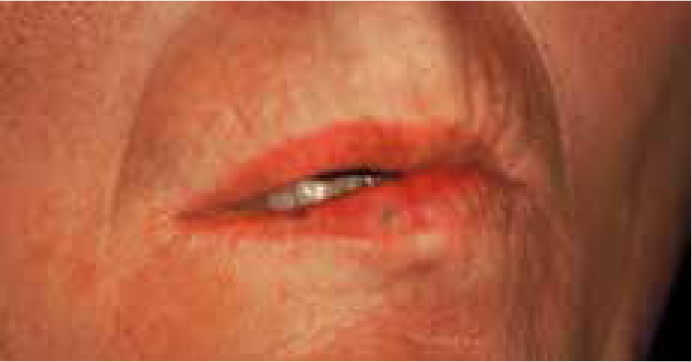Article


A 59-year-old woman complained of paralysis of the right side of her lip, over the previous two days, following the appearance of oral ulceration, and pain in her tongue and palate, and associated difficulty in closing her eye on the same side. She had not experienced any head injury or any chemical exposure, had normal blood pressure and was not on any medications.
Examination showed right-sided complete facial palsy but no skin lesions (Figure 1). The patient could not grin to show her teeth nor close her eyes. There were no other neurological signs.

Oral examination revealed right maxillary ulcerations. Her paralysis showed significant improvement over the next two weeks.
Q1. Which is the probable cause of facial paralysis?
A1. The answer to which is the probable cause of the facial paralysis?
(a) Stroke is characterized by loss of brain activities (temporary or not), usually due to ischaemia or haemorrhage, causing an inability to move limbs, speak and/or understand and see. The main risk factors are older age, high blood pressure, tobacco smoking and heavy alcohol drinking. Stroke is not the cause for the facial paralysis in this patient as her paralysis duration was short but without numbness or weakness in her arms or legs, or difficulty in speaking, yet the oral ulcerations were unilateral. Additionally, the younger age of our patient, her abstention from alcohol or tobacco and normal blood pressure eliminate the risk for stroke.
(b) Lower motor neuron lesion is the most common cause of acute facial paralysis resulting from a dysfunction of the VII cranial nerve (facial nerve). Lower motor neuron lesion is the cause in our patient as her paralysis came on gradually within 2 days after her first oral complaints. This paralysis affects all the facial muscles on the affected side and is characterized by a less rapid onset of palsy than seen in a stroke, and no other neurological features. The distribution and type of oral lesions are typical of herpes zoster infection (Ramsay Hunt syndrome type 2), an uncommon but well recognized cause of a lower motor neuron lesion.
(d) Lyme disease can cause a similar lower motor neuron facial palsy. This disease is endemic worldwide and caused by the spirochaete Borrelia borgdoferri and is transmitted by deer ticks. The paralysis from Lyme disease is usually painless, often bilateral, and mainly in children, in contrast to that seen in our patient.
(c) Brain or other tumours (benign or malignant) associated with facial nerve branches can press or invade the nerve and cause facial palsy. Brain tumours, parotid carcinomas or lymphomas and acoustic neuromas or choleosteatomas may be responsible, but the palsy is typically slowly progressive, persistent or recurrent. Surgical procedures, especially for the removal of various tumours along the VII nerve, can also damage some nerve fibres, causing a permanent palsy.
(e) Multiple sclerosis (MS) is an immune-mediated process in which an abnormal immune response, directed against CNS, attacks myelin, eventually causing a nerve sclerosis. Facial palsy is a relatively early common finding in MS patients but is associated with i) general symptomatology, such as fatigue, tingling sensations, visual, bowel and bladder problems, cognitive and emotional changes; ii) abnormal reflexes and iii) MRI changes. Although the patient had facial palsy, she was older at the onset than many MS patients and lacked the clinical and laboratory diagnostic landmarks of MS.
